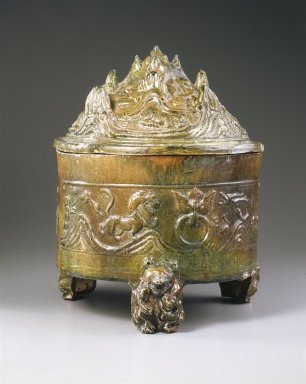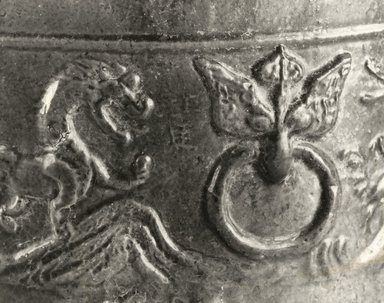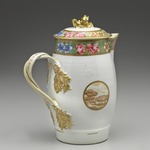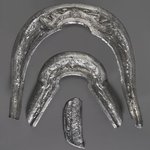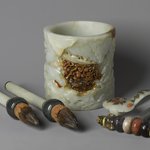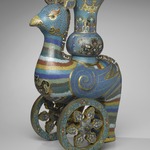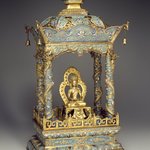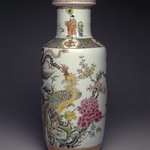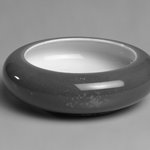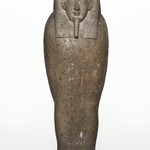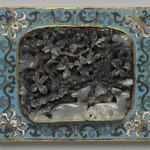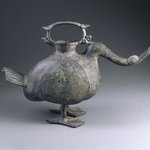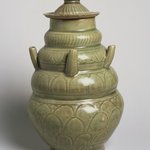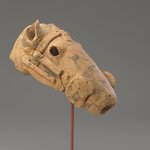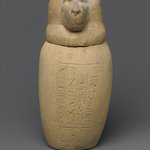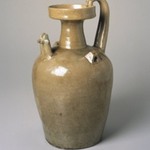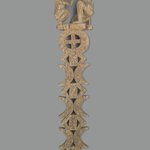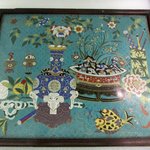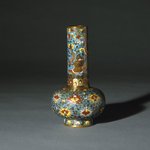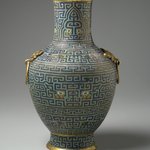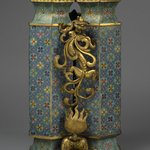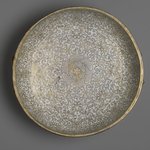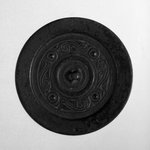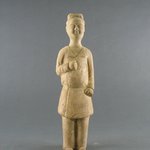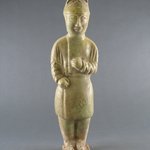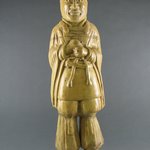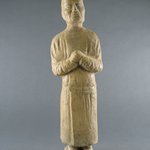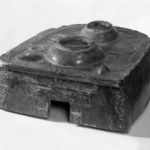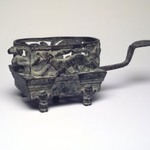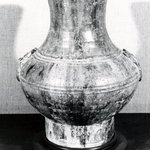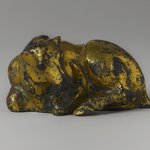Hill Jar and Cover
Asian Art
On View: Asian Galleries, West, 2nd floor (China)
This jar might represent either Mount Bo or Mount Kunlun, two sacred Daoist mountains, and evokes the journey of the deceased to the immortal realms. The Animals of the Four Directions (sishen) that provide celestial navigation are strategically placed in the undulating peaks of the mountain. The legs of the vessel are formed by auspicious bears, which were popular in Han-dynasty art for their protective power; one crouching bear clutches her cubs tightly while grinning. The mythical beasts include deer, symbolizing longevity, and the figure of an immortal chasing a tiger.
MEDIUM
Earthenware with lead glaze
DATES
206 B.C.E.–220 C.E.
DYNASTY
Han Dynasty
PERIOD
Han Dynasty
ACCESSION NUMBER
1995.49a-b
CREDIT LINE
Purchase gift of Dr. Bertram H. Schaffner, Mr. and Mrs. Milton F. Rosenthal, Mr. and Mrs. Greg Fitz-Gerald, and Mr. and Mrs. Robert L. Poster, Helen Babbott Sanders Fund, Charles Stewart Smith Memorial Fund, Caroline A.L. Pratt Fund, and Caroline H. Polhemus Fund
CATALOGUE DESCRIPTION
The so-called Hill Jar is a well known type of Han dynasty tomb pottery. The present jar shows the typical form of a wide straight sided cylindrical body resting on three legs and covered with a conical top. The body is decorated with a continuous moulded frieze of wild animals and mythical beasts, including bears, boars, and the four directional animals of Chinese mythology (dragon, tiger, phoenix and a tortoise with a snake). On opposite sides of the vessel are two pushou handles, press moulded in low relief showing a stylized animal head holding a ring. There is an inscription moulded in clay body on one side of the jar. The first character reads ju. The second reads ma. The two seams joining the ends of the slab built body are clearly visible on each side of the vessel. The Three press-moulded and carved legs are in the form of grinning bears each clutching two bear cubs. The top is moulded and carved in the form of mountains around a central peak. The mountains are decorated in moulded relief with wild beasts and mythical animals. The top of the jar was fired upside down, allowing the glaze to run and collect at the tops of the mountain peaks.
Condition: The Hill Jar and cover are generally intact. On the cover, the glaze is chipped on the tops of three of the mountain peaks and there is a chip on one of the low relief animals. The underside of the vessel, the mouth rim and the rim of the cover all show kiln marks from firing n contact with other vessels. The nose of one bear on one of the legs has been chipped. Many areas of the glaze on the jar and the cover show a slight iridescence from burial. There are identical round adhesive dealer's labels on the bottom of the vessel and the inside cover.
CAPTION
Hill Jar and Cover, 206 B.C.E.–220 C.E. Earthenware with lead glaze, 11 1/2 x 8 3/4 in. (29.2 x 22.2 cm). Brooklyn Museum, Purchase gift of Dr. Bertram H. Schaffner, Mr. and Mrs. Milton F. Rosenthal, Mr. and Mrs. Greg Fitz-Gerald, and Mr. and Mrs. Robert L. Poster, Helen Babbott Sanders Fund, Charles Stewart Smith Memorial Fund, Caroline A.L. Pratt Fund, and Caroline H. Polhemus Fund, 1995.49a-b. Creative Commons-BY (Photo: Brooklyn Museum, 1995.49a-b_SL1.jpg)
IMAGE
overall, 1995.49a-b_SL1.jpg. Brooklyn Museum photograph
"CUR" at the beginning of an image file name means that the image was created by a curatorial staff member. These study images may be digital point-and-shoot photographs, when we don\'t yet have high-quality studio photography, or they may be scans of older negatives, slides, or photographic prints, providing historical documentation of the object.
RIGHTS STATEMENT
Creative Commons-BY
You may download and use Brooklyn Museum images of this three-dimensional work in accordance with a
Creative Commons license. Fair use, as understood under the United States Copyright Act, may also apply.
Please include caption information from this page and credit the Brooklyn Museum. If you need a high resolution file, please fill out our online
application form (charges apply).
For further information about copyright, we recommend resources at the
United States Library of Congress,
Cornell University,
Copyright and Cultural Institutions: Guidelines for U.S. Libraries, Archives, and Museums, and
Copyright Watch.
For more information about the Museum's rights project, including how rights types are assigned, please see our
blog posts on copyright.
If you have any information regarding this work and rights to it, please contact
copyright@brooklynmuseum.org.
RECORD COMPLETENESS
Not every record you will find here is complete. More information is available for some works than for others, and some entries have been updated more recently. Records are frequently reviewed and revised, and
we welcome any additional information you might have.
